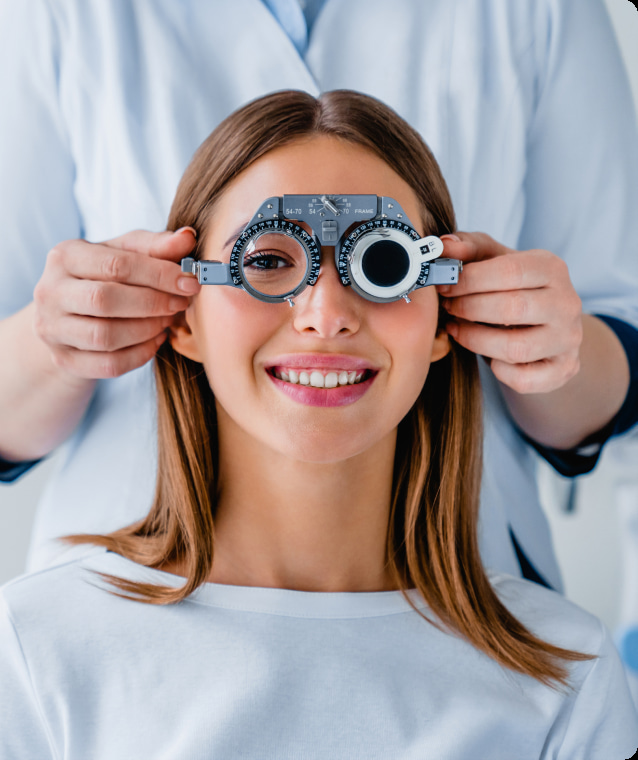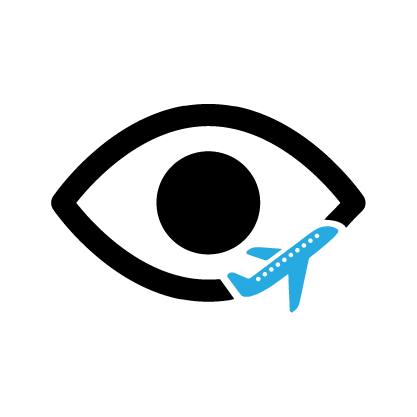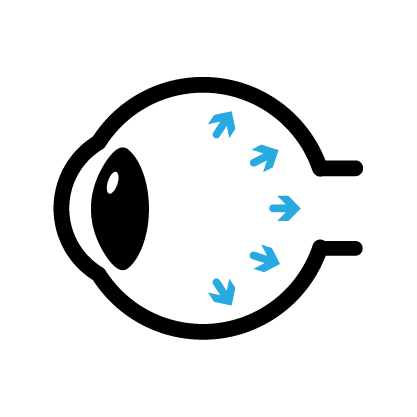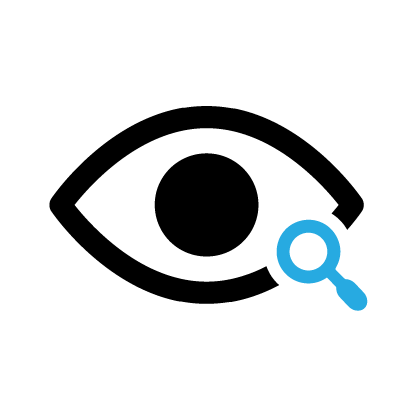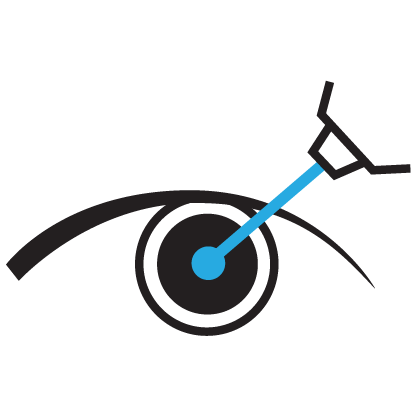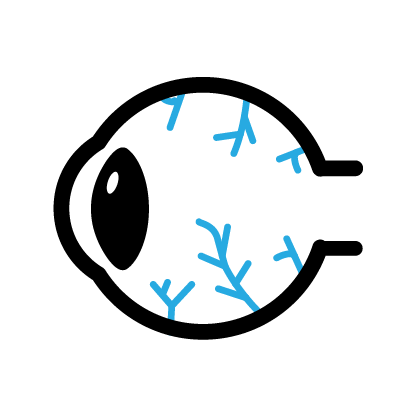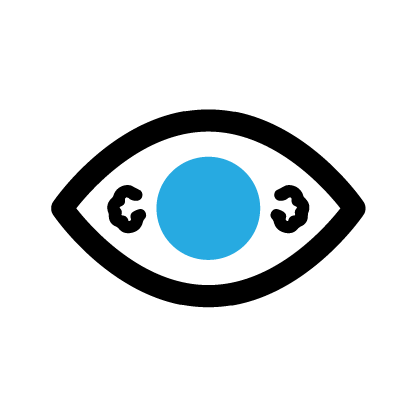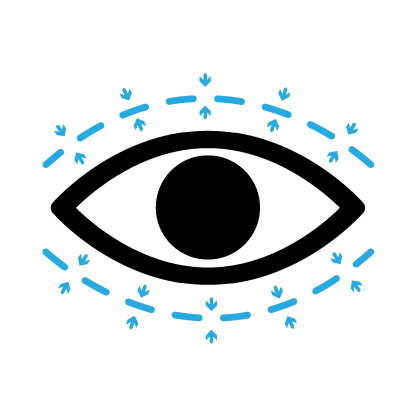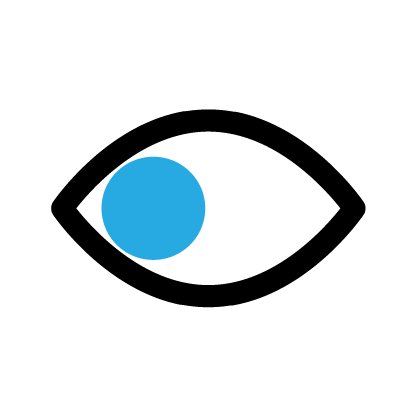About General Ophthalmology
Our eyes are susceptible to various conditions that can affect both vision and overall health. At Moorfields Eye Hospital in Dubai and Abu Dhabi, we offer comprehensive General Ophthalmology services to address a wide spectrum of eye conditions, ensuring thorough care for patients across all ages. Whether routine eye examinations or diagnosing and managing common and complex eye conditions, our highly skilled team leverages cutting-edge diagnostic technologies to deliver superior outcomes.

Here are some of the conditions we commonly treat:
- Refractive Errors: Myopia (nearsightedness), hyperopia (farsightedness), astigmatism, and presbyopia are conditions that cause blurry vision and affect a person’s ability to see clearly at various distances.
- Eye Infections: Bacterial, viral, and fungal eye infections can affect different eye parts of the eyes, leading to discomfort and potential vision impairment.
- Dry Eyes: This is a chronic condition in which the eyes do not produce enough tears or evaporate quickly.
- Conjunctivitis (Pink Eye): An inflammation or infection that lines your eyelid and covers the white part of your eyeball, resulting in redness, itching, and discharge.
- Blepharitis: A common condition that causes inflammation of the eyelids, leading to irritated, itchy eyelids and the formation of dandruff-like scales on eyelashes.
- Corneal Abrasion (Scratch): A painful scrape or scratch on the eye’s surface that can occur from contact with dust, dirt, wood shavings, makeup brushes, sports equipment or contact lenses.
- Chalazion (Eye Cyst): A small lump or swelling on the eyelid caused by a blocked oil gland can cause mild pain or irritation.
Conditions & Treatment
Astigmatism
About
Astigmatism is a refractive condition in which the eye’s optical system is incapable of forming a point image for a point object (images are misconstrued).Astigmatism
About
Astigmatism is a refractive condition in which the eye’s optical system is incapable of forming a point image for a point object (images are misconstrued).Blepharitis
About
Blepharitis is a common condition that causes inflammation of the eye lids and can affect people of all ages. It usually affects the rim of the eyelids of both eyes and usually is not serious but still irritating and uncomfortable. Eyelids may become crusty and scaly and eyes may feel gritty and very tired with increasing irritation when outdoors in sunshine or around any polluted or smoke filled environment.Blepharitis
About
Blepharitis is a common condition that causes inflammation of the eye lids and can affect people of all ages. It usually affects the rim of the eyelids of both eyes and usually is not serious but still irritating and uncomfortable. Eyelids may become crusty and scaly and eyes may feel gritty and very tired with increasing irritation when outdoors in sunshine or around any polluted or smoke filled environment.Chalazion
About
Chalazion is a cyst on the eye lids and develops when a meibomian gland gets blocked and leads to swelling, and it can be of variable size. For the first few days the cyst is inflamed and you might see a small white head on the top of it which then tends to shrink, but might take months to disappear completelyChalazion
About
Chalazion is a cyst on the eye lids and develops when a meibomian gland gets blocked and leads to swelling, and it can be of variable size. For the first few days the cyst is inflamed and you might see a small white head on the top of it which then tends to shrink, but might take months to disappear completelyConjunctivitis
About
Pink eye or Conjunctivitis is a common condition which causes the surface of your eye to go red and, often, sticky or watery and your eye becomes sore. There are two types of conjunctivitis:- Viral conjunctivitistends to cause a watery red eye and can last for two to three weeks even with the correct treatment. Generally, viral conjunctivitis does not affect vision but in some cases vision may become blurry or see glare when looking at lights. This is due to an inflammatory reaction causing small white dots on the cornea, the transparent window at the front of the eye. These usually fade with time, but it can take a few weeks or even months.
- Bacterial conjunctivitisis more likely to cause a red eye with a sticky yellow discharge.
Conjunctivitis
About
Pink eye or Conjunctivitis is a common condition which causes the surface of your eye to go red and, often, sticky or watery and your eye becomes sore. There are two types of conjunctivitis:- Viral conjunctivitistends to cause a watery red eye and can last for two to three weeks even with the correct treatment. Generally, viral conjunctivitis does not affect vision but in some cases vision may become blurry or see glare when looking at lights. This is due to an inflammatory reaction causing small white dots on the cornea, the transparent window at the front of the eye. These usually fade with time, but it can take a few weeks or even months.
- Bacterial conjunctivitisis more likely to cause a red eye with a sticky yellow discharge.
Corneal abrasion
About
Corneal abrasions are little scratches on the cornea of the eye. They are usually caused as a result from trauma (injury) to the surface of the eye. Common causes include poking of the eye, quick movements close to the eye, and getting dust in the eye, especially if the eye is then rubbed. Injuries can also be caused by contact lens insertion and removal.Corneal abrasion
About
Corneal abrasions are little scratches on the cornea of the eye. They are usually caused as a result from trauma (injury) to the surface of the eye. Common causes include poking of the eye, quick movements close to the eye, and getting dust in the eye, especially if the eye is then rubbed. Injuries can also be caused by contact lens insertion and removal.Dry Eyes
What is dry eye disease?
Dry Eye Disease is a condition in which the eye does not produce tears properly, or when the tears are not of the correct consistency and evaporate too rapidly. If left untreated, this condition can lead to inflammation and pain, ulcers, scarring of the cornea, and some loss of vision. For individuals who are suffering from with condition, seeking the expertise of dry eye specialists is essential to identify the main cause of symptoms and the specific type of dry eye disease to get appropriate treatment. Dry Eye disease can affect the quality of life of the sufferer; dry eye can make it more difficult to perform some everyday activities, such as using a computer or reading for an extended period of time, and it can also reduce tolerance to dry environments, such as an aeroplane cabin. There are many factors involved in DED, which is a chronic and progressive disease that produces a range of symptoms and can potentially lead to damaging the eyes.Dry Eyes
What is dry eye disease?
Dry Eye Disease is a condition in which the eye does not produce tears properly, or when the tears are not of the correct consistency and evaporate too rapidly. If left untreated, this condition can lead to inflammation and pain, ulcers, scarring of the cornea, and some loss of vision. For individuals who are suffering from with condition, seeking the expertise of dry eye specialists is essential to identify the main cause of symptoms and the specific type of dry eye disease to get appropriate treatment. Dry Eye disease can affect the quality of life of the sufferer; dry eye can make it more difficult to perform some everyday activities, such as using a computer or reading for an extended period of time, and it can also reduce tolerance to dry environments, such as an aeroplane cabin. There are many factors involved in DED, which is a chronic and progressive disease that produces a range of symptoms and can potentially lead to damaging the eyes.Eye Infection
About
Eye infections can invade the eyeball or the area around it – they are generally microorganisms that can be harmful, including viruses, bacteria and fungi.Eye Infection
About
Eye infections can invade the eyeball or the area around it – they are generally microorganisms that can be harmful, including viruses, bacteria and fungi.Eye Redness
About
A bloodshot ‘red eye’ may be worrying but is rarely serious or causes pain. Symptoms often disappear within a few days, without treatment. But if it does not improve within a few days, there may be a more serious problem.Eye Redness
About
A bloodshot ‘red eye’ may be worrying but is rarely serious or causes pain. Symptoms often disappear within a few days, without treatment. But if it does not improve within a few days, there may be a more serious problem.Hypermetropia
About
Hypermetropia is a common refractive condition of the eye in which vision is better for distant objects than for near objects. It can be called far-sightedness or hypermetropia.It results from the eyeball being smaller than average, causing images to be focused behind the retina. In hypermetropia, the light is focused too far back in the eye, behind the retina, which causes things to look blurred close-up.
Many very young children have mild hypermetropia that gets better by itself as they grow older.
Hypermetropia
About
Hypermetropia is a common refractive condition of the eye in which vision is better for distant objects than for near objects. It can be called far-sightedness or hypermetropia.It results from the eyeball being smaller than average, causing images to be focused behind the retina. In hypermetropia, the light is focused too far back in the eye, behind the retina, which causes things to look blurred close-up.
Many very young children have mild hypermetropia that gets better by itself as they grow older.
Itchy eyes
About
Usually, itchy eyes are the result of an allergy although there are other possible causes, depending on the symptoms.Itchy eyes
About
Usually, itchy eyes are the result of an allergy although there are other possible causes, depending on the symptoms.Presbyopia
About
Presbyopia is a condition which makes it difficult to focus on close objects. With age, by the mid-forties, people experience blurred vision at close points, such as reading, sewing or working on a computer.Presbyopia it is not a disease as it is a results of the natural ageing process of the eye and it cannot be prevented .
Presbyopia
About
Presbyopia is a condition which makes it difficult to focus on close objects. With age, by the mid-forties, people experience blurred vision at close points, such as reading, sewing or working on a computer.Presbyopia it is not a disease as it is a results of the natural ageing process of the eye and it cannot be prevented .
Myopia
About
Myopia is a common refractive condition commonly referred to as near or short sightedness. People with Myopia can see near objects clearly but distant objects are blurry. Myopia occurs when the cornea and lens focus the light in front of the retina instead of exactly on it, usually because the eye is a little larger than it should be.Myopia
About
Myopia is a common refractive condition commonly referred to as near or short sightedness. People with Myopia can see near objects clearly but distant objects are blurry. Myopia occurs when the cornea and lens focus the light in front of the retina instead of exactly on it, usually because the eye is a little larger than it should be.Request an Appointment
